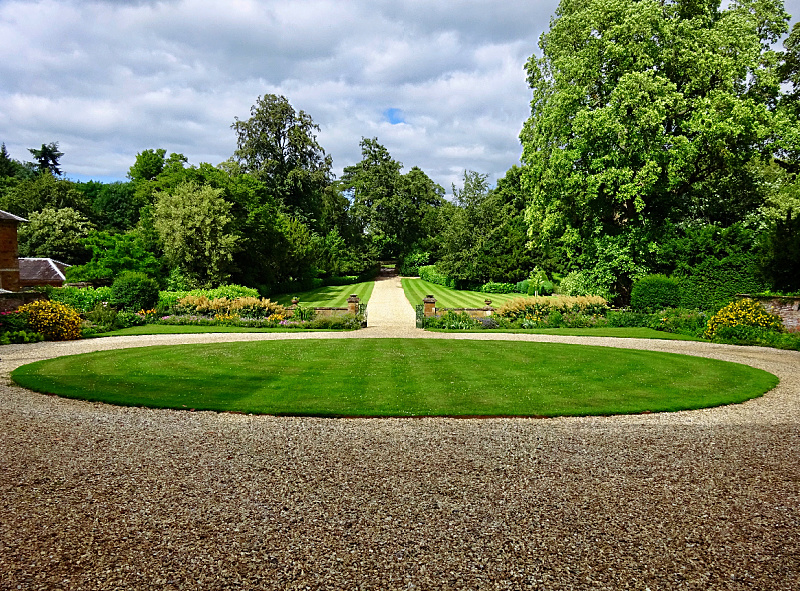........ is a honey coloured country house built in 1692 by William Holbech, and although now owned by the NT, it is still administered and lived in by members of the Holbech family. We discovered this exquisite property late in the day arriving just one hour before it closed. We would have been really disappointed if we had arrived after closing time - it is only open for two afternoons per week.
Come join me and wander along its elegant driveway which leads to the front of the property. Built in the Carolean style, the house is surrounded by beautiful gardens and a wonderful landscape.
There are no photos allowed of the inside - this is courtesy the NT. However, it does show some of the exquisite plasterwork, plus the homely domestic scale of the property. The room originally had five Canaletto's on the walls, but the paintings seen today are copies which were done by a Chinese painter in the 1920s. The original Canalletos were all sold to cover death duties.
A cloud hedge separates the terrace, and formal gardens from the surrounding parkland. The 500 acres are a rare examaple of a ferme ornée, or ornamental farm. The style was devised by English garden designer Stephen Switzer in 1742 and described as 'an ornamental landscape within a traditional working farm'. The S shape of the lake gives the impression of a meandering river. There is a walk around the parkland giving views across the landscape from an 18-metre-high obelisk, an oval pavillion
and an Ionic temple.
Roses and lavender scent the air, a tranquil spot in which to enjoy the surroundings, and view the summer flowers.
We made our way back via Banbury to the old inn where we were staying.













The room might have had five Canaletto's on the walls, but the original Canalletos had to be sold to cover the death duties. Can you imagine what those death duties were worth :(
ReplyDeleteI hope the family didn't have to sell off some land as well because the gardens were/are the estate's pride and joy.
The death duties must have been enormous blow to the family but the land remains intact, and as you mention it really is a pride and joy.
Delete"Cloud hedge" -- lovely term and artistic look that is new to me! I learned that Banbury Cross poem as a nursery rhyme when I was a wee one!
ReplyDeleteI believe that Cloud pruning originates in Japan and is known as 'Niwaki'.
DeleteI've never heard of a "cloud hedge" before - though some of my early attempts at hedge-cutting came pretty close! A lovely tour of the grounds and I'm sure the house was equally appealing.
ReplyDeleteThe house is well worth visiting. I met the lady who lived there and she was a really friendly and welcoming person.
DeleteExpensive affair dying with death duties, from what I've heard and read over the years some families had to sell their homes.
ReplyDeleteTruly a beautiful garden with the hedge looking wonderful being done that way Rosemary.
The inside does look lovely but I am not understand of why heaters are put underneath a window where the cold comes in...perhaps you know why.
Apparently by placing radiators directly underneath the window, hot air is produced and released, which then rises to hit the cold air which eminates from the window.
DeleteLooks like you got good weather for your visit. Like the rose gardens and the lake views the best.
ReplyDeleteThe lake view from the rose garden is stunning.
DeleteYou had me with the opening statement, Rosemary, “a honey-coloured country house.” What an exquisite description. The tour did not disappoint.
ReplyDeleteWe loved everything about this property - even the village where it resided was picture perfect too.
DeleteHello Rosemary, I especially admired the garden structures and outbuildings here. So many of these tend to disappear over time. Although I wouldn't mind having five Canalettos myself, I think the family made a good decision to preserve instead those unusual and good-looking grounds.
ReplyDelete--Jim
Hello Jim - death duties really took their toll on many fine estates during the 1920s and 30s, but the result has been that the majority of grand properties are now open to the public.
DeleteThank you. Loved every minute of it.
ReplyDeletePleased that you enjoyed Susan - thank you.
DeleteWhat a great tour.
ReplyDeleteThanks - glad you enjoyed.
DeleteSo beautiful! What a lovely tour...
ReplyDeleteTitti
Thank you Titti for your kind comment.
DeleteWhat a beautiful place, I'm glad you arrived in time, I enjoyed the tour. Death duties are insidious. Never heard of a cloud hedge, but I can see how it got it's name. The statue of the lady on the horse is exquisite.
ReplyDeleteIf ever you are in that area Polly this is a property that is well worth seeking out.
DeleteDear Rosemary - We are so lucky, too, to be able to see your reports about this lovely place. The house building is beautiful. I’ve been interested in the British type of green hedges with interesting curves or topiary, but cloud hedge is new to me. How nice to see the parklands as an extension of the garden!
ReplyDeleteYoko
Dear Yoko - it is my understanding that the cloud hedges were a development that happened here as a result of seeing Japanese 'Niwaki'.
DeleteWhat a lovely place to visit. Oh my goodness, I had not thought of that Ride a Cock Horse verse in ever so long. It was a joy to read again.
ReplyDelete💙
DeleteAn elegant and beautiful property.
ReplyDelete👍
DeleteYour photos of the house in the late afternoon sun (particularly photos #2 and 3) are beautiful! The meandering lake, the cloud hedge, and the intricate plaster work are all lovely and interesting features of the property.
ReplyDeleteArriving late worked out to our advantage as we were able to enjoy the whole place virtually to ourselves.
Delete